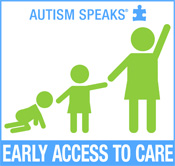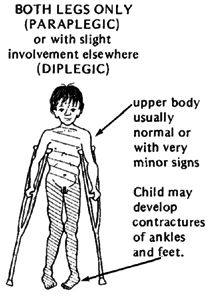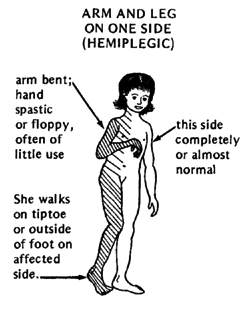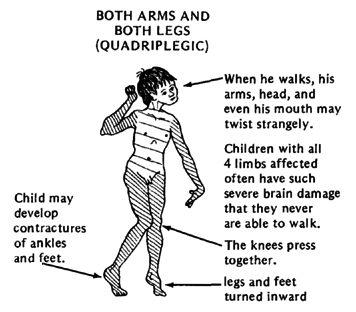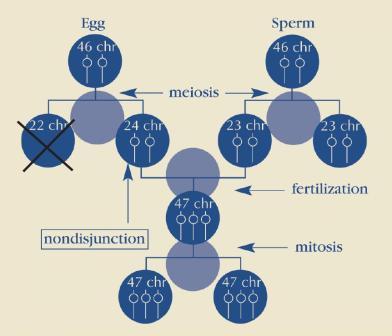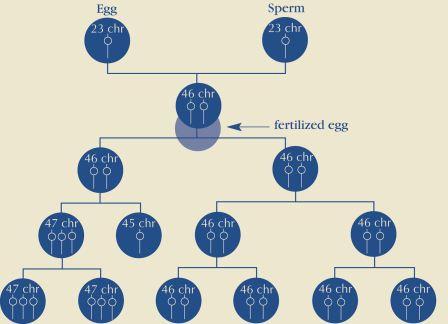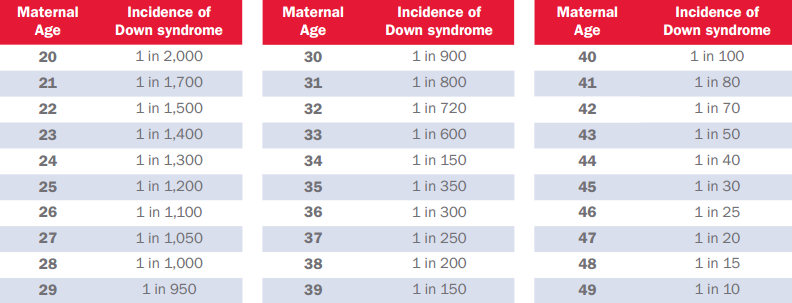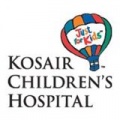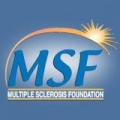Pediatric Patient Resources: Difference between revisions
Leana Louw (talk | contribs) No edit summary |
Kim Jackson (talk | contribs) m (Formatting and updating links) |
||
| (7 intermediate revisions by the same user not shown) | |||
| Line 7: | Line 7: | ||
<br> | <br> | ||
= | == Introduction == | ||
This | This page contains resources for physiotherapists and families relating to rare conditions diagnosed within the pediatric population. | ||
== Autism Spectrum Disorder and Autism [[Image:Autism ribbon.png|120x132px]] == | |||
===Definition=== | |||
Group of complex disorders of the brain. Varying degrees of characteristics including: difficulties in social interaction, verbal and nonverbal communication and repetitive behaviors<ref name="Autism Speaks">Autism Speaks. It's Time to Listen. Available from:http://www.autismspeaks.org/ (accessed 27/06/2013).</ref>. | |||
* Autism Spectrum Disorder (ASD): can display with intellectual disabilities, difficulties in coordination and attention and physical health issues. | * Autism Spectrum Disorder (ASD): can display with intellectual disabilities, difficulties in coordination and attention and physical health issues. | ||
* Autism: most obvious signs and symptoms tend to emerge between 2 and 3 years old | * Autism: most obvious signs and symptoms tend to emerge between 2 and 3 years old | ||
=== | ===How Common Are Autism And ASD? === | ||
* ASD: Affects over 2 million individuals in the United States | * ASD: Affects over 2 million individuals in the United States | ||
* Autism: | * Autism: | ||
| Line 51: | Line 25: | ||
** An estimated 1 out of 54 boys and 1 in 252 girls are diagnosed in the United States | ** An estimated 1 out of 54 boys and 1 in 252 girls are diagnosed in the United States | ||
=== | ===Causes=== | ||
* No one cause | * No one cause | ||
* Rare gene changes Most cases are a combination of gene changes and environmental factor | * Rare gene changes Most cases are a combination of gene changes and environmental factor | ||
| Line 65: | Line 39: | ||
** Untreated phenylketonuria (PKU) | ** Untreated phenylketonuria (PKU) | ||
=== | ===How is ASD/Autism Diagnosed?=== | ||
* No specific medical test | * No specific medical test | ||
* Administer autism-specific | * Administer autism-specific behavioural evaluations | ||
* Parents usually notice: | * Parents usually notice: | ||
** Failure to make eye contact | ** Failure to make eye contact | ||
| Line 82: | Line 56: | ||
* Genetic testing may be recommended | * Genetic testing may be recommended | ||
=== | ===Resources for Autism=== | ||
'''Kentucky Autism Training Center''' | '''Kentucky Autism Training Center''' | ||
* [http://katcproviders.louisville.edu/ Find specific services by region or county] | * [http://katcproviders.louisville.edu/ Find specific services by region or county] | ||
| Line 95: | Line 69: | ||
'''National Institute of Neurological Disorders and Stroke''' | '''National Institute of Neurological Disorders and Stroke''' | ||
* [http://www.ninds.nih.gov/disorders/autism/detail_autism.htm Fact sheet] on ASD and Autism | * [http://www.ninds.nih.gov/disorders/autism/detail_autism.htm Fact sheet] on ASD and Autism | ||
'''Autism Research Institute''' | '''Autism Research Institute''' | ||
* Find out about current research | |||
* http://www.autism.com/ | |||
'''[http://www.autism-society.org/ Autism Society]''' | '''[http://www.autism-society.org/ Autism Society]''' | ||
* Has news, research and ways to get involved | * Has news, research and ways to get involved | ||
| Line 102: | Line 77: | ||
== Cerebral Palsy (CP) [[Image:Cerebral-palsy-awareness-ribbon.jpg.png|120x132px]] == | == Cerebral Palsy (CP) [[Image:Cerebral-palsy-awareness-ribbon.jpg.png|120x132px]] == | ||
=== | ===Definition=== | ||
[[Cerebral Palsy Introduction|Cerebral Palsy]] describes a disorder of movement, muscle tone or posture that is caused by injury or abnormal development in the immature brain.<ref name="Mayo">Mayo Clinic. Cerebral Palsy. Available from:http://www.mayoclinic.com/health/cerebral-palsy/DS00302/DSECTION=complications (accessed 30/06/2013).</ref> | |||
=== | ===How Common is CP? <ref name="American Prego">American Pregnancy Association: Promoting Pregnancy Wellness. Cerebral Palsy. United Cerebral Palsy. Available from:http://americanpregnancy.org/birthdefects/cerebralpalsy.htm (accessed 30/06/2013).</ref>=== | ||
* Usually not diagnosed until the age of 2 or 3 | * Usually not diagnosed until the age of 2 or 3 | ||
* ~2-3:1,000 children over the age of three have the condition | * ~2-3:1,000 children over the age of three have the condition | ||
* ~500,000 children and adults have CP in the United States | * ~500,000 children and adults have CP in the United States | ||
=== | ===Types<ref name="American Prego" /> === | ||
* [[Spasticity|Spastic]]: | * [[Spasticity|Spastic]]: | ||
** ~70-80% of cases | ** ~70-80% of cases | ||
| Line 145: | Line 120: | ||
*** Difficulty with motions that require precise coordination | *** Difficulty with motions that require precise coordination | ||
=== | ===Causes<ref name="Mayo" />=== | ||
* Abnormality or disruption in brain development | * Abnormality or disruption in brain development | ||
* Random mutations in genes | * Random mutations in genes | ||
| Line 154: | Line 129: | ||
* [[Traumatic Brain Injury|Traumatic head injury]] | * [[Traumatic Brain Injury|Traumatic head injury]] | ||
=== | ===Risk Factors<ref name="Mayo" />=== | ||
* Mother’s health: | * Mother’s health: | ||
** Certain infections or health problems significantly increase the chance to giving birth to a baby with CP: | ** Certain infections or health problems significantly increase the chance to giving birth to a baby with CP: | ||
| Line 174: | Line 149: | ||
** Multiple babies | ** Multiple babies | ||
=== | ===How is CP Diagnosed?<ref name="Mayo" />=== | ||
* Signs and symptoms usually appear during infancy or preschool years: | * Signs and symptoms usually appear during infancy or preschool years: | ||
** Impaired movement associated with: | ** Impaired movement associated with: | ||
| Line 206: | Line 181: | ||
*** Other developmental delays<br> | *** Other developmental delays<br> | ||
=== | ===Resources for Cerebral Palsy=== | ||
'''[http://cerebralpalsy.org/ MyChild™]:''' | '''[http://cerebralpalsy.org/ MyChild™]:''' | ||
* Their mission: “to provide you with the most comprehensive resource and compassionate voice for all things related to caring for a child with cerebral palsy, and other neurological conditions. We strive, everyday, to be your ULTIMATE Resource for EVERYTHING Cerebral Palsy.” | * Their mission: “to provide you with the most comprehensive resource and compassionate voice for all things related to caring for a child with cerebral palsy, and other neurological conditions. We strive, everyday, to be your ULTIMATE Resource for EVERYTHING Cerebral Palsy.” | ||
'''[http://cerebralpalsyresources.com/kentucky Cerebral Palsy Resources]''' | '''[http://cerebralpalsyresources.com/kentucky Cerebral Palsy Resources]''' | ||
'''[http://www.mattinglycenter.org/aboutus.html Mattingly Center, Inc.]''' | '''[http://www.mattinglycenter.org/aboutus.html Mattingly Center, Inc.]''' | ||
* Cerebral Palsy School of Louisville, Inc. | * Cerebral Palsy School of Louisville, Inc. | ||
* Their mission “To provide the highest quality of structured day services for adults with severe developmental disabilities.” | * Their mission “To provide the highest quality of structured day services for adults with severe developmental disabilities.” | ||
== | == Down Syndrome [[Image:Down.syndrome.ribbon.magnet.jpg|120x132px]] == | ||
=== | ===Definition=== | ||
[[Down Syndrome (Trisomy 21)|Down's Syndrome]] is a genetic disorder occurring when the individual has full or a partial copy of chromosome 21. This extra genetic material causes an alteration in the development of the child.<ref name="NDSS">National Down Syndrome Society. Down Syndrome. National Down Syndrome Society. http://www.ndss.org/Down-Syndrome/What-Is-Down-Syndrome/. Published 2012. Accessed June 24, 2013.</ref> | |||
=== | ===How Common is Down's Syndrome?=== | ||
* Most common genetic disorder | * Most common genetic disorder | ||
* ~1:691 babies are born each year with Down’s Syndrome | * ~1:691 babies are born each year with Down’s Syndrome | ||
* ~6,000 babies are born each year with Down’s Syndrome | * ~6,000 babies are born each year with Down’s Syndrome | ||
=== | ===Types=== | ||
* Trisomy 21 (Nondisjunction): | * Trisomy 21 (Nondisjunction): | ||
** The pair of the 21st chromosome fails to separate | ** The pair of the 21st chromosome fails to separate | ||
| Line 239: | Line 214: | ||
*** Accounts for ~4% of cases | *** Accounts for ~4% of cases | ||
=== | ===Causes=== | ||
* Cause of non-disjunction is currently unknown: | * Cause of non-disjunction is currently unknown: | ||
** Research suggests the likelihood increases as women age | ** Research suggests the likelihood increases as women age | ||
| Line 247: | Line 222: | ||
**Note: Age 34 is not accurate. NDSS has noted the error but has yet to find out the correct information. | **Note: Age 34 is not accurate. NDSS has noted the error but has yet to find out the correct information. | ||
=== | ===How is Down’s Syndrome Diagnosed? === | ||
<u>Prenatally</u> | <u>Prenatally</u> | ||
* Screening tests: | * Screening tests: | ||
| Line 270: | Line 245: | ||
** This is done by drawing a sample of the baby’s blood | ** This is done by drawing a sample of the baby’s blood | ||
=== | ===Resources for Down Syndrome=== | ||
'''[http://www.downsyndromeoflouisville.org/ Down Syndrome of Louisville]''' | '''[http://www.downsyndromeoflouisville.org/ Down Syndrome of Louisville]''' | ||
* Lifelong learning center for individuals with Down Syndrome | * Lifelong learning center for individuals with Down Syndrome | ||
| Line 308: | Line 283: | ||
*'''[http://yellowbrickroadshop.com/ Yellow Brick Road Shop]''' | *'''[http://yellowbrickroadshop.com/ Yellow Brick Road Shop]''' | ||
*'''[http://www.especialneeds.com/home.php eSpecial Needs]''' | *'''[http://www.especialneeds.com/home.php eSpecial Needs]''' | ||
</div> | </div> | ||
== Resources == | |||
[[Image:Kosair.jpg|120x132px]] | |||
'''Kosair Childrens Hospital''' | |||
* Look into conditions and services | |||
* Find a doctor | |||
* See current news | |||
* Visit their [http://www.kosairchildrens.com/ health library] | |||
<br> '''Pediatric Leukemias''' | |||
* The Children’s Hospital of Philadelphia | |||
* In depth [http://www.chop.edu/service/oncology/cancers-explained/leukemia-diagnosis-and-treatment.html resource of pediatric leukemias]<br> [[Image:Logo.gif]] | |||
'''Pediatric Rheumatology''' | |||
* [http://www.ped-rheum.com/content/6/1/16 Review of childhood sarcoidosis] <br> [[Image:Msf.jpg|120x132px]] | |||
'''Multiple Sclerosis Foundation''' | |||
* Insight on pediatric MS | |||
* [http://www.msfocus.org/article-details.aspx?articleID=374 Coping with MS] | |||
<br> '''Failure to Thrive''' | |||
* Clinical key by Elsevier | |||
* [https://www.clinicalkey.com/topics/pediatrics/failure-to-thrive.html In depth overview of diagnosis]<br> | |||
'''National Organization for Rare Diseases''' | |||
* Search the [http://www.rarediseases.org/rare-disease-information/rare-diseases rare disease database] and download the free report | |||
<br> '''The Global Genes Project''' | |||
* [http://globalgenes.org/ Learn what they are about] | |||
* Get involved | |||
* Resources available: | |||
** Search their [http://globalgenes.org/rarelist/ RARE list] | |||
** Search their [http://globalgenes.org/rarefacts/ RARE facts] | |||
== References == | == References == | ||
| Line 315: | Line 319: | ||
[[Category:Bellarmine_Student_Project]] | [[Category:Bellarmine_Student_Project]] | ||
[[Category:Cerebral_Palsy]] | [[Category:Cerebral_Palsy]] | ||
[[Category:Paediatrics]] | |||
[[Category:Resources - Paediatrics]] | |||
Latest revision as of 12:21, 1 April 2020
Original Editor - Alicia Dupilka
Top Contributors - Alicia Dupilka, Elaine Lonnemann, Kim Jackson, Leana Louw, WikiSysop, Admin and Scott Buxton
Introduction[edit | edit source]
This page contains resources for physiotherapists and families relating to rare conditions diagnosed within the pediatric population.
Autism Spectrum Disorder and Autism  [edit | edit source]
[edit | edit source]
Definition[edit | edit source]
Group of complex disorders of the brain. Varying degrees of characteristics including: difficulties in social interaction, verbal and nonverbal communication and repetitive behaviors[1].
- Autism Spectrum Disorder (ASD): can display with intellectual disabilities, difficulties in coordination and attention and physical health issues.
- Autism: most obvious signs and symptoms tend to emerge between 2 and 3 years old
How Common Are Autism And ASD? [edit | edit source]
- ASD: Affects over 2 million individuals in the United States
- Autism:
- Effects ~1:88 children
- ~4-5 more times likely in boys than girls
- An estimated 1 out of 54 boys and 1 in 252 girls are diagnosed in the United States
Causes[edit | edit source]
- No one cause
- Rare gene changes Most cases are a combination of gene changes and environmental factor
- Risk factors (do not cause autism by themselves, but could have an influence when combined with genetic risk factors):
- Clearest evidence involve events before and during birth
- Advance age at conception
- Maternal illness during pregnancy
- Difficulties during birth (i.e. Oxygen deprivation)
- Genetic risk factors (Autism tends to happen more frequently in the following conditions)[2]
- Fragile X Syndrome
- Tuberous sclerosis
- Congenital rubella syndrome
- Untreated phenylketonuria (PKU)
How is ASD/Autism Diagnosed?[edit | edit source]
- No specific medical test
- Administer autism-specific behavioural evaluations
- Parents usually notice:
- Failure to make eye contact
- Not responding to their name
- Playing with toys in unusual or repetitive ways
- Other signs
- The Modified Checklist of Autism in Toddlers:
- List of informative questions about child
- Answers can indicate whether further evaluation by a specialist is needed
- Typical diagnosis involves a multidisciplinary team
- Genetic testing may be recommended
Resources for Autism[edit | edit source]
Kentucky Autism Training Center
- Find specific services by region or county
- Examples of services include: hippo therapy, social skills group, community living supports and day care
Autism Society of Kentuckiana
- Become a member
- Find resources, learn about news and events
- Offers an autism dad’s group
- Has information on current news and research, family services and events around the United States
- There is also a blog available; as well as ideas for autism apps
National Institute of Neurological Disorders and Stroke
- Fact sheet on ASD and Autism
Autism Research Institute
- Find out about current research
- http://www.autism.com/
- Has news, research and ways to get involved
- Section about living with Autism
Cerebral Palsy (CP)  [edit | edit source]
[edit | edit source]
Definition[edit | edit source]
Cerebral Palsy describes a disorder of movement, muscle tone or posture that is caused by injury or abnormal development in the immature brain.[3]
How Common is CP? [4][edit | edit source]
- Usually not diagnosed until the age of 2 or 3
- ~2-3:1,000 children over the age of three have the condition
- ~500,000 children and adults have CP in the United States
Types[4][edit | edit source]
- Spastic:
- ~70-80% of cases
- Associated with stiff muscles, making movement difficult
- Spastic diplegia:
- Both legs are affected
- Causes tight muscles in the hips and legs
- Inward turned legs leading to crossed knees (scissoring)
- Spastic hemiplegia:
- One side of the body affected
- Arm often more affected than the leg
- Spastic hemiplegia:
- Spastic quadriplegia:
- Most severe
- All four limbs and the trunk are affected
- Often also affect muscle of tongue and mouth
- Spastic quadriplegia:
- Athetoid or Dyskinetic:
- 10-20% of cases
- Affects entire body
- Fluctuations in muscle tone
- Uncontrolled movements
- Difficulty with:
- Learning to control body
- Sucking
- Swallowing
- Speech
- Ataxic
Causes[3][edit | edit source]
- Abnormality or disruption in brain development
- Random mutations in genes
- Infections of the mother that would affect the developing baby
- Disruption of blood supply to the developing brain
- Lack of oxygen to the baby’s brain
- Infant infections leading to inflammation around the brain
- Traumatic head injury
Risk Factors[3][edit | edit source]
- Mother’s health:
- Certain infections or health problems significantly increase the chance to giving birth to a baby with CP:
- Rubella
- Syphilis
- Chickenpox
- Other conditions
- Certain infections or health problems significantly increase the chance to giving birth to a baby with CP:
- Infant’s health:
- Certain illnesses in a newborn significantly increase the chance of the baby developing CP:
- Bacterial meningitis
- Severe or untreated jaundice (yellowing of the skin)
- Viral encephalitis
- Certain illnesses in a newborn significantly increase the chance of the baby developing CP:
- Other factors:
- Premature birth
- Low birth weight
- Breech births
- Multiple babies
How is CP Diagnosed?[3][edit | edit source]
- Signs and symptoms usually appear during infancy or preschool years:
- Impaired movement associated with:
- Exaggerated reflexes or rigidity of the limbs and trunk
- Abnormal posture
- Involuntary movements
- Unsteadiness of walking
- Combination of these
- Other signs and symptoms
- Impaired movement associated with:
- Brain scans:
- MRI: usually the preferred test to use, will usually be given a mild sedative to remain still
- Cranial ultrasound: can provide a preliminary assessment, placed over the soft spot (fontanel) of the baby’s head
- CT scan: will likely be given a mild sedative to remain still
- Electroencephalogram (EEG):
- Done if the child has a history of seizures
- Records the electrical activity of the brain
- Used to determine if child has epilepsy
- Lab tests:
- Blood is checked to rule out other conditions
- May also screen for metabolic or genetic problems
- Additional tests:
- If diagnosed with CP, may go through these other tests to screen for other associated conditions:
- Vision impairment
- Hearing impairment
- Speech delays or impairments
- Intellectual disabilities or mental retardation
- Other developmental delays
- If diagnosed with CP, may go through these other tests to screen for other associated conditions:
Resources for Cerebral Palsy[edit | edit source]
- Their mission: “to provide you with the most comprehensive resource and compassionate voice for all things related to caring for a child with cerebral palsy, and other neurological conditions. We strive, everyday, to be your ULTIMATE Resource for EVERYTHING Cerebral Palsy.”
- Cerebral Palsy School of Louisville, Inc.
- Their mission “To provide the highest quality of structured day services for adults with severe developmental disabilities.”
Down Syndrome  [edit | edit source]
[edit | edit source]
Definition[edit | edit source]
Down's Syndrome is a genetic disorder occurring when the individual has full or a partial copy of chromosome 21. This extra genetic material causes an alteration in the development of the child.[5]
How Common is Down's Syndrome?[edit | edit source]
- Most common genetic disorder
- ~1:691 babies are born each year with Down’s Syndrome
- ~6,000 babies are born each year with Down’s Syndrome
Types[edit | edit source]
- Trisomy 21 (Nondisjunction):
- The pair of the 21st chromosome fails to separate
- Extra chromosome is replicated in every cell in the body
- Accounts for ~95% of cases
- Mosaicism:
- Nondisjunction takes place in chromosome 21 in one cell but not all cells
- Accounts for ~1% of cases
- May have fewer characteristics than other types of Down’s Syndrome
- Mosaicism:
- Translocation:
- Part of chromosome 21 breaks off during cell division and attaches to another chromosome, typically chromosome 14
- Accounts for ~4% of cases
- Translocation:
Causes[edit | edit source]
- Cause of non-disjunction is currently unknown:
- Research suggests the likelihood increases as women age
- No definitive research suggesting environmental factors of the parents before or during pregnancy
- Note: Age 34 is not accurate. NDSS has noted the error but has yet to find out the correct information.
How is Down’s Syndrome Diagnosed?[edit | edit source]
Prenatally
- Screening tests:
- Most only provide a probability
- Blood test: measures quantities of various substances in the mother’s blood
- Ultrasound: checks for “markers”
- Diagnostic tests:
- Can provide a definite diagnosis with almost 100% accuracy
- Carry up to a 1% risk of causing a spontaneous termination
- Chorionic villus sampling (CVS): usually performed in first trimester between 9 and 11 weeks
- Amniocentesis: usually performed in the second trimester after 15 weeks
- Diagnostic tests:
At birth
- Usually identified by certain physical traits:
- Low muscle tone
- Single deep crease across the palm of the hand
- Slightly flattened facial profile
- Upward slant to the eyes
- Chromosomal analysis may also need to be done to confirm the diagnosis:
- This is done by drawing a sample of the baby’s blood
Resources for Down Syndrome[edit | edit source]
- Lifelong learning center for individuals with Down Syndrome
- National Down Syndrome Society
- Information about Down Syndrome
- Lists resources including:
- Publications
- Managing behavior
- Research
- And more!
National Association for Down Syndrome
- Programs
- Resources and information
Real Life Down Syndrome
- Blog spot
- Gives insight on how to raise a child with DS
- Search resources by state
Kentucky Parent Support Groups
- Lists support groups by county
Activities and Equipment Sites for the Pediatric Population[edit | edit source]
Below is a list of equipment sites for you to look around:
Resources[edit | edit source]
Kosair Childrens Hospital
- Look into conditions and services
- Find a doctor
- See current news
- Visit their health library
Pediatric Leukemias
- The Children’s Hospital of Philadelphia
- In depth resource of pediatric leukemias

Pediatric Rheumatology
Multiple Sclerosis Foundation
- Insight on pediatric MS
- Coping with MS
Failure to Thrive
- Clinical key by Elsevier
- In depth overview of diagnosis
National Organization for Rare Diseases
- Search the rare disease database and download the free report
The Global Genes Project
- Learn what they are about
- Get involved
- Resources available:
- Search their RARE list
- Search their RARE facts
References[edit | edit source]
- ↑ Autism Speaks. It's Time to Listen. Available from:http://www.autismspeaks.org/ (accessed 27/06/2013).
- ↑ Autism Society. Improving the Lives of All Affected by Autism. Available from: http://www.autism-society.org/ (Accessed 27/06/2013).
- ↑ 3.0 3.1 3.2 3.3 Mayo Clinic. Cerebral Palsy. Available from:http://www.mayoclinic.com/health/cerebral-palsy/DS00302/DSECTION=complications (accessed 30/06/2013).
- ↑ 4.0 4.1 American Pregnancy Association: Promoting Pregnancy Wellness. Cerebral Palsy. United Cerebral Palsy. Available from:http://americanpregnancy.org/birthdefects/cerebralpalsy.htm (accessed 30/06/2013).
- ↑ National Down Syndrome Society. Down Syndrome. National Down Syndrome Society. http://www.ndss.org/Down-Syndrome/What-Is-Down-Syndrome/. Published 2012. Accessed June 24, 2013.
